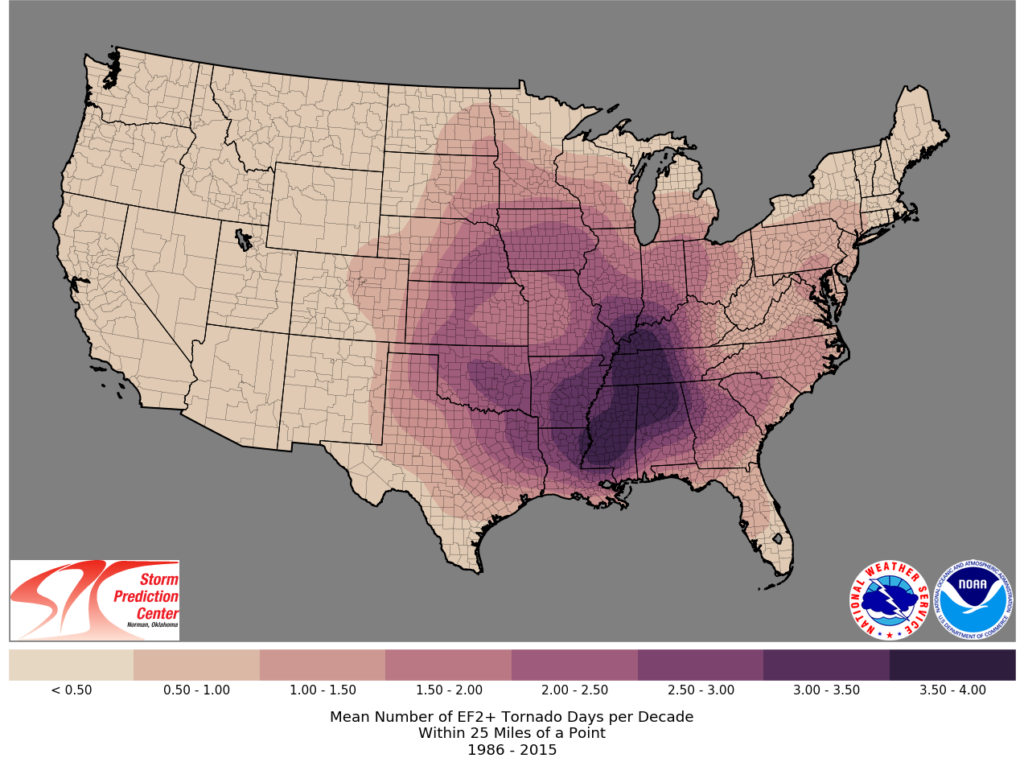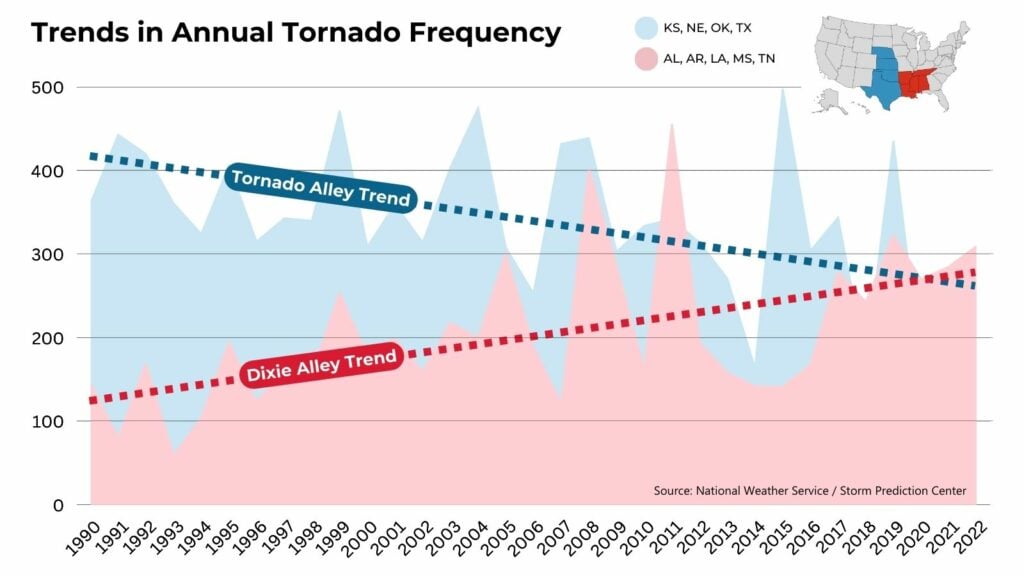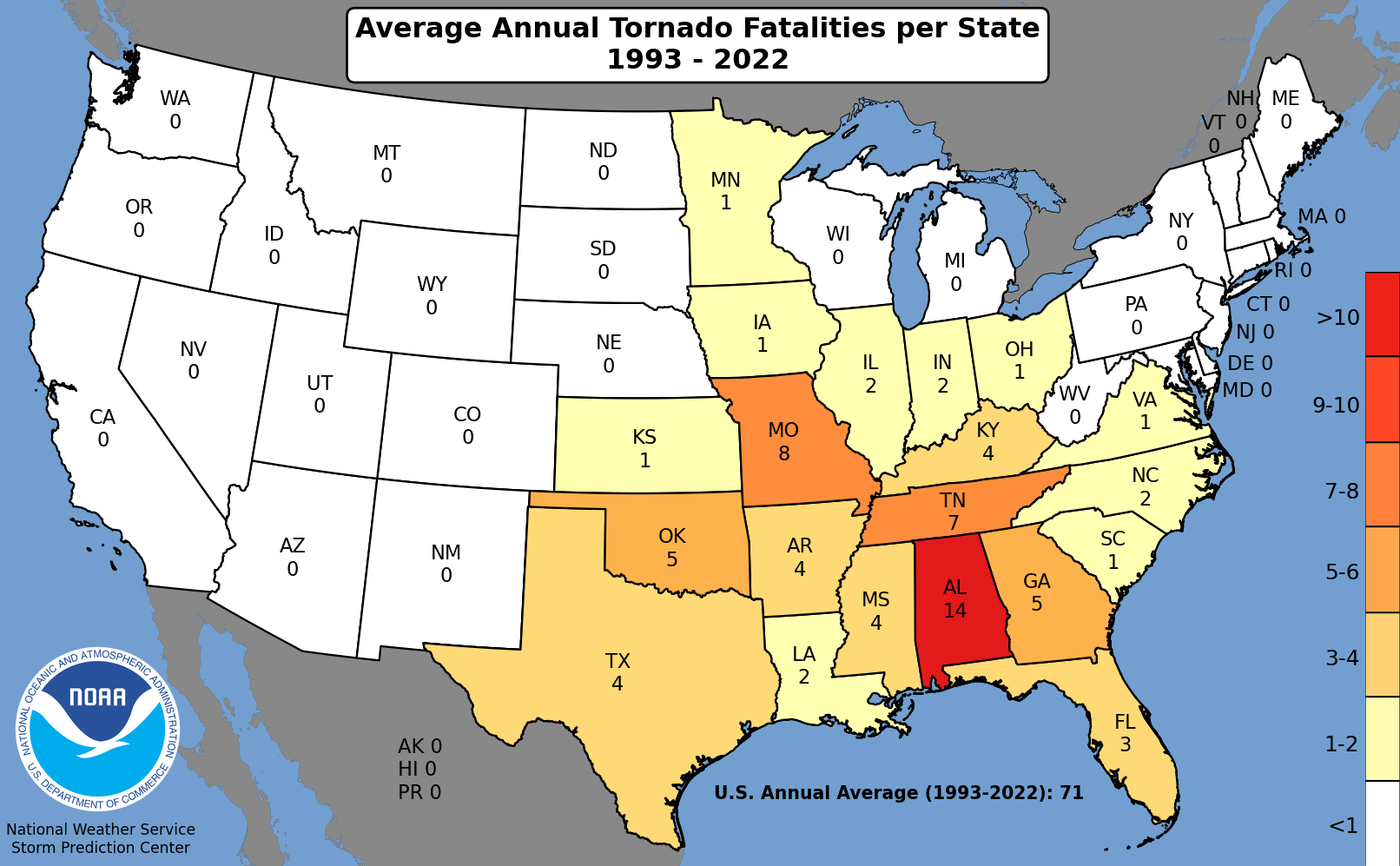Les scènes des films Twister et Le Magicien d'Oz ne sont plus aussi fréquentes qu'avant dans la Tornado Alley. La fréquence des tornades a plus que doublé dans la région surnommée "Dixie Alley" depuis 1990.
Le changement quantifié
Cette année, la saison des tornades a démarré de manière presque record dans le Sud. Les données du Storm Prediction Center (SPC) suggèrent que la densité et la fréquence des tornades de forte intensité - celles classées EF2 ou plus sur l'échelle Fujita améliorée - ont augmenté dans cette région au cours des 30 dernières années.
Emily Dobbs est analyste SIG et météorologue pour Baron Weather. Elle a vu plusieurs reportages sur ce changement au cours des dernières années, mais beaucoup d'entre eux manquaient de preuves scientifiques crédibles.
"Pour les tornades, le centroïde est une mesure statistique plus utile. Et comme il s'agit d'un point unique représentant le point le plus central de toutes les trajectoires, il révèle des tendances dans le temps qu'il est difficile de dégager avec d'autres méthodes", a-t-elle déclaré.
Emily a constaté que le centroïde décennal de toutes les trajectoires de tornades fortes s'est déplacé de 110 miles vers l'est au cours des 30 dernières années.
Des données crédibles sur les tornades sont disponibles auprès du SPC depuis 1950, mais ce n'est qu'à l'ère du numérique que les rapports sont devenus plus fiables.
"D'importantes avancées technologiques au cours des dernières décennies ont permis d'améliorer la prédiction, le suivi et la détection des tornades, notamment grâce au radar Doppler, à l'imagerie aérienne et aux médias sociaux", ajoute Emily. "Il est probable que de nombreuses tornades n'aient pas été enregistrées les années précédentes, ce qui aurait faussé les données.
Autres tendances dans la vallée des tornades
Le déplacement géospatial des fortes tornades vers l'est a fait l'objet de recherches approfondies depuis le début du 21e siècle, et de nombreuses caractéristiques distinctives ont été observées. Par exemple, le SPC a constaté qu'un nouveau maximum de jours de tornades s'est développé dans le Tennessee, le Mississippi et l'Alabama depuis 1986.

La fréquence des tornades fortes a également plus que doublé dans les États méridionaux de l'Arkansas, du Tennessee, de la Louisiane, de l'Alabama et du Mississippi (ligne rouge) par rapport à 1990. Dans le même temps, les tornades fortes ont diminué de 30 % dans les États des Grandes Plaines (Nebraska, Kansas, Oklahoma et Texas) (ligne bleue).

Pourquoi "Dixie Alley" est plus mortelle
Les tornades de la Dixie Alley diffèrent également dans le temps et en termes d'impact. Elles se produisent plus souvent la nuit, parfois pendant la saison froide, et ont tendance à être enveloppées de pluie. La proximité du golfe du Mexique permet à l'humidité et à l'instabilité d'être plus présentes à l'avant des tempêtes dans le Deep South. Selon une étude d'évaluation des risques réalisée en 2020, la capacité à protéger les vies et les biens dans cette région est également fortement compromise par des facteurs socio-économiques tels que l'infrastructure et la pauvreté.

Tous ces facteurs rendent les tornades de la Dixie Alley plus dangereuses, et les chiffres parlent d'eux-mêmes. Depuis 1993, les tornades ont fait plus de victimes chaque année dans des États comme l'Alabama et le Tennessee qu'au Kansas et en Oklahoma.
Il est essentiel pour les communicateurs et les intervenants en cas de phénomènes météorologiques extrêmes de se tenir au courant de ces tendances. L'évolution du climat peut influencer les conditions atmosphériques, telles que le cisaillement du vent, l'humidité et la température, qui favorisent l'apparition de tornades.
"À mesure que nous progressons sur le plan technologique, il est important d'analyser ces modèles afin d'identifier les tendances", explique Emily. "L'avenir nous dira si nous continuerons à observer ce déplacement des tornades vers l'est.
Surmonter les inégalités en matière de rapports
Baron Weather a fondé la technologie de suivi des orages que l'on retrouve aujourd'hui dans presque toutes les applications météorologiques. La chronologie ci-dessous retrace trois décennies d'innovation de Baron dans l'intérêt de la sécurité du public face aux orages violents.
Le produit Baron Shear Rate (souvent appelé "Spin Detector" par les radiodiffuseurs) est l'une des avancées les plus récentes. Cet indice simple à trois niveaux élimine les autres images radar, appelées "bruit", pour aider les responsables de la sécurité publique à se concentrer uniquement sur les éléments d'un orage violent qui mettent la vie en danger. Cette technologie de détection peut aider à combler les lacunes dans les zones où les rapports sont insuffisants, ou tard dans la nuit, lorsque les tornades sont difficiles à repérer.
Comprendre le risque pour votre vie ou vos biens est la première étape. Prendre des mesures immédiates sur la base de données intelligentes et fiables est la bouée de sauvetage. La technologie exclusive de suivi des tempêtes mentionnée dans cet article est disponible pour les diffuseurs, les professionnels de la sécurité publique et les développeurs d'applications via l'API Baron ou Esri Marketplace. Nous avons  est à votre disposition pour vous aider à trouver des solutions adaptées à vos besoins.
est à votre disposition pour vous aider à trouver des solutions adaptées à vos besoins.
